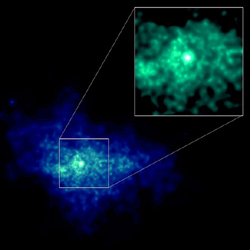June 25, 2002
RELEASE: 02-07
Astronomers from the University of Massachusetts and Columbia University have found the "bulls-eye" pulsar in a bright ring of high-energy particles in a distant supernova remnant. This discovery, made with NASA's Chandra X-ray Observatory and the Arecibo Radio Telescope, will help scientists better understand how neutron stars channel enormous amounts of energy into particles moving near the speed of light.
Chandra's image of the supernova remnant SNR G54.1+0.3 reveals a bright, point-like central source, which is surrounded by a ring and two jet-like structures in an extended nebula of high-energy particles. The radio data show that this bright central source is a neutron star, or pulsar, that is rotating 7 times per second.
"The features Chandra found appear to be due to the energetic flow of radiation and particles from a rapidly spinning neutron star formed during a supernova event," said Fangjun Lu of the University of Massachusetts at Amherst who led the X-ray research.
Lu and colleagues informed Fernando Camilo of Columbia University in New York of this detection. Camilo and his collaborators then used the powerful Arecibo telescope to look for the tell-tale radio pulsations from a neutron star at the center of the ring. After a search in August 2001 was aborted by radio-frequency interference, they observed the source again in April 2002 and found a weak, pulsating radio source. Further observations indicate the pulsar (and hence the supernova remnant) has an age of approximately 3000 years. Analysis of 1997 ASCA satellite data confirmed that the source is pulsing in X-rays as well.
"This discovery is an excellent example of how the superb resolution of Chandra and the improved capabilities of Arecibo worked together to quickly resolve an outstanding scientific question," said Camilo. "We look forward to continued substantial progress in understanding the properties of young neutron stars."
Intense electric fields around the neutron star accelerate particles to form jets blasting away from the poles and a disk of matter and anti-matter flowing away from the equator at high speeds. As the equatorial flow rams into particles and magnetic fields in the nebula, a shock wave forms. The shock wave then boosts the particles to extremely high energies causing them to glow in X-rays and produce the bright ring. The particles continue to stream outward from the ring and the jets to supply the extended nebula, which spans approximately 6 light years.
The features observed in SNR G54.1+0.3 are very similar to other "pulsar wind nebulas" found by Chandra in the Crab Nebula, the Vela supernova remnant, and B1509-58. By analyzing the similarities and differences between these objects, scientists hope to better understand the fascinating process of transforming the rotational energy of the neutron star into extremely high-energy particles with very little frictional heat loss.
Chandra observed SNR G54.1+0.3 on June 6-7, 2001, using the Advanced CCD Imaging Spectrometer instrument. The radio data on the central pulsar, known as PSR J1930+1852, were gathered at Arecibo on April 29, 2002. The results from this work appear in two separate papers in the March 20 and July 20, 2002 issues of the Astrophysical Journal Letters.
The Arecibo Observatory is part of the National Astronomy and Ionosphere Center (NAIC), operated by Cornell University under a cooperative agreement with the National Science Foundation (NSF). NASA's Marshall Space Flight Center, Huntsville, Ala., manages the Chandra program for the Office of Space Science, Washington, DC. TRW, Inc., Redondo Beach, Calif., is the prime contractor for the spacecraft. The Smithsonian's Chandra X-ray Center controls science and flight operations from Cambridge, Mass.
MEDIA CONTACTS
Steve Roy
Marshall Space Flight Center, Huntsville, AL
Phone: 256-544-6535
Megan Watzke
Chandra X-ray Observatory Center, CfA, Cambridge, MA
Phone: 617-496-7998
cxcpress@cfa.harvard.edu



